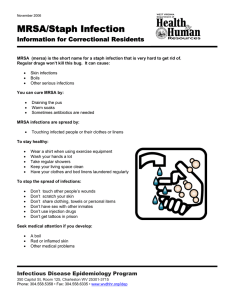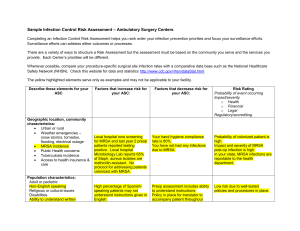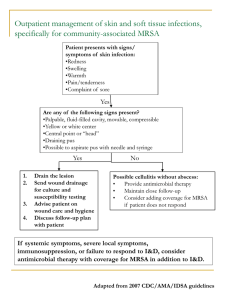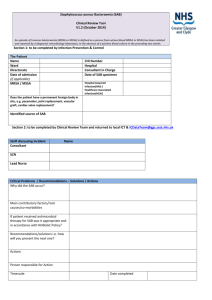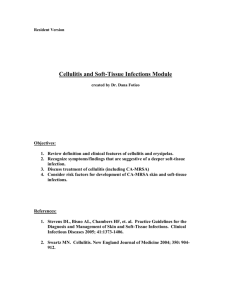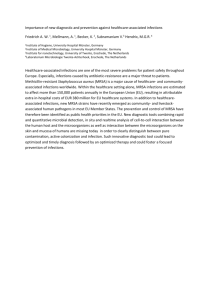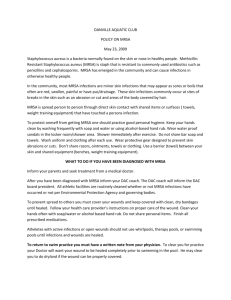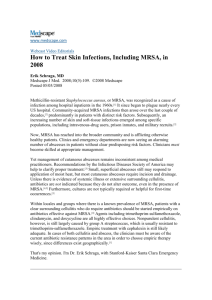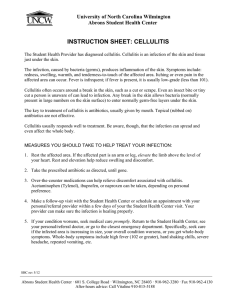Skin and Soft Tissue Infections
advertisement
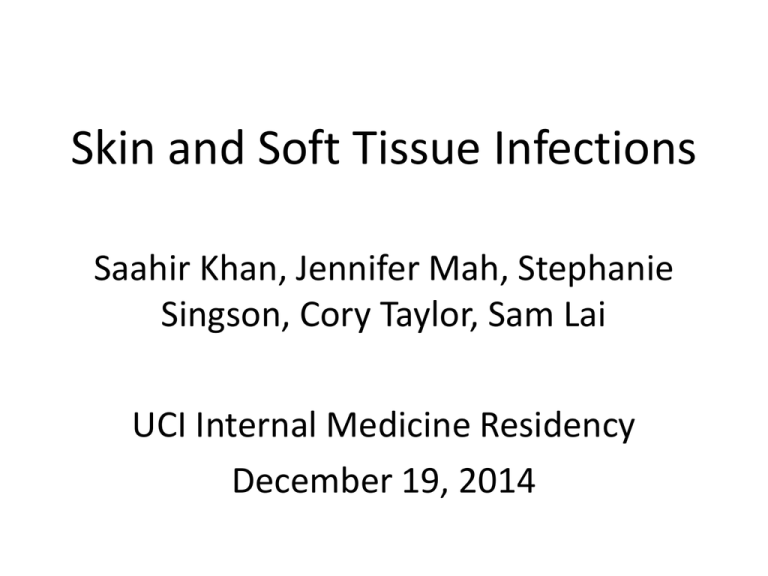
Skin and Soft Tissue Infections Saahir Khan, Jennifer Mah, Stephanie Singson, Cory Taylor, Sam Lai UCI Internal Medicine Residency December 19, 2014 Pathogenesis Necrotizing Fascitis Erysipelas Deep Vein Thrombosis Contact Dermatitis Cellulitis Erythema Multiforme Ecthyma Folliculitis Impetigo superficial • Impetigo – – – – – Non-Bullous: GAS, MSSA, rarely MRSA Bullous: MSSA with exfoliative toxin, rarely MRSA, purulent If localized, topical treatment x 5 days unless risk for MRSA If widespread, oral treatment against MSSA x 7 days unless risk for MRSA Staphylococcal Scalded Skin Syndrome: IV nafcillin + clindamycin for toxin • Ecthyma – GAS, MSSA, rarely MRSA, use oral treatment against MSSA x 7 days unless risk for MRSA – Ecthyma Gangenosum: immunocomprise or trauma, Pseudomonas, systemically ill • Folliculitis – MSSA, MRSA, rarely Pseudomonas (hot tub), Aeromonas (lake), fungal – Use warm compress or topical treatment • Furuncule/Carbuncle/Abscess – – – – deep MSSA, MRSA, purulent Treat with incision and drainage Adjunctive oral treatment against MSSA if SIRS or incomplete drainage Empiric treatment against MRSA if colonized, septic, immunocompromised, failed treatment, or high MRSA prevalence – If recurrent in same location, look for anatomic cause, consider decolonization – If multiple locations, look for immunodeficiency, consider decolonization Stevens, DL, Bisno, AL, Chambers, HF, et al. Practice guidelines for the diagnosis and management of skin and soft tissue infections: 2014 update by the Infectious Diseases Society of America. Clin Infect Dis. 2014. superficial • Erysipelas, Cellulitis – – – – – – – GAS, MSSA, MRSA Culture blood if immunocompromised, animal bite, exposure Use oral treatment against MSSA if uncomplicated Use systemic treatment if SIRS Use treatment against MRSA if trauma, colonization, septic Use broad treatment including gram-negatives if immunocompromised Hospitalize if SIRS, immunocompromised, poor adherence, failed treatment, or concern for deep infection – Treat after 4 days post-op if SIRS and wound inflammation with site-dependent regimen – Treat for 5 days, then extend until symptoms resolve – For recurrence, address underlying anatomic causes, consider prophylaxis if 4/year • Necrotizing Fascitis deep – – – – – – – – Type 1 = Mixed anaerobic and facultative (strep, gram-negatives), Type 2 = GAS Clostridial Myonecrosis: C. perfringens, gas-producing Prompt surgical consultation if suspected Workup with MRI if able to be performed quickly or CT and culture of blood and abscess Use broad IV treatment including anaerobes, add clindamycin for toxin if suspecting GAS Treat within 2-4 days post-op if SIRS and wound purulence with GAS or Clostridium If persistently bacteremic, look for residual or metastatic abscess or endocarditis Treat for 3 weeks, can use oral abx if blood clear, no endocarditis, no abscess Stevens, DL, Bisno, AL, Chambers, HF, et al. Practice guidelines for the diagnosis and management of skin and soft tissue infections: 2014 update by the Infectious Diseases Society of America. Clin Infect Dis. 2014. Moderate: SIRS Severe: septic, failed treatment, immunocompromised, deep involvement Stevens, DL, Bisno, AL, Chambers, HF, et al. Practice guidelines for the diagnosis and management of skin and soft tissue infections: 2014 update by the Infectious Diseases Society of America. Clin Infect Dis. 2014. Swartz, MN. Cellulitis. N Engl J Med. 2004; 350:904-12. Empiric Treatment against GAS/MSSA Stevens, DL, Bisno, AL, Chambers, HF, et al. Practice guidelines for the diagnosis and management of skin and soft tissue infections: 2014 update by the Infectious Diseases Society of America. Clin Infect Dis. 2014. Empiric Oral Treatment against MRSA Daum, RS. Skin and soft-tissue infections caused by methicillin-resistant Staphylococcus aureus. N Engl J Med. 2007; 357:380-90. 1. A 24 year old male is evaluated for an increasingly painful boil on his back that has been present for 3 days and has increased in size. The patient has had similar lesions on his back and chest previously, but these were smaller and spontaneously drained and resolved with requiring medical attention. The remainder of the medical history is non contributory. On physical exam, vital signs are normal and the patient is not all appearing. Examination of the back discloses a 7cm fluctuant, tender, oval shaped lesion, with surrounding erythema extending 3cm from the edge of lesion. The remainder of the physical exam is normal. An aspirate of the lesion reveals purulent material, a Gram stain of which demonstrates many leukocytes and many gram positive cocci in clusters. A culture is sent for procession. Incision and drainage of the lesion produces approximately 5ml of pus. Which of the following is the most appropriate antibiotic treatment for this patient? A. Amoxicillin- Clavulanate B. Azithromycin C. Moxifloxacin D. Rifampin E. Trimpethoprim-Sulfamethoxazole Answer: E. TMP-SMX is an older antibiotic that has been used with increasing frequency for treatment of skin and soft tissue infections caused my community associated MRSA and it has retained excellent activity against most trains of CA-MRSA. This patient presents with a cutaneous abscess that is larger than 5cm with purulent drainage and associated cellulitis. A gram stain of the lesion aspirate is suggestive of S. aureus which is consistent with CA-MRSA infection. Treatment with TMP-SMX is appropriate empiric therapy after drainage of the lesion. Limitations of TMP-SMX include sulfa allergy, hyperkalemia, and possible kidney toxicity. Amoxicillin-Clavulanate is an expanded spectrum beta lactam that is not active against MRSA. Azithromycin, a macrolide,has poor activity against MRSA. Moxifloxacin, a fluoroquinolne, has increased activity against S. aureus compared with other fluoroquinolones but resistance to this agent has emerged among CA-MRSA strains. Rifampin has activity against some CAMRSA strains but should not be used as a single agent for treatment of infection because of the risk of rapid emergence of resistance. Key Point: Trimethoprim-Sulfamethoxazole is a first line choice for treatment of skin and soft tissue infection due to suspected or confirmed community associated MRSA. 2. A 25 year old woman is evaluated for redness that developed over her right leg at the site of a mosquito bite. She is otherwise healthy and takes no medications. On physical exam, temperature is 37.2C, BP 120/70, HR 70/min, RR 14/min. There is an erythematous 3x3-cm patch on the right thigh. The area is warm to touch with no evidence of purulence, fluctuance, crepitus or lymphadenopathy. Which of the following is the most appropriate empiric outpatient therapy? A. Cephalexin B. Doxycline C. Fluconazole D. Metronidazole E. Trimethoprim-Sulfamethoxazole Answer: A. The patient has non purulent cellulitis that is most likely caused by group A B-hemolytic streptococci and empiric treatment with a B-lactam agent such as Cephalexin or Dicloxacillin is recommended. Cellulitis is a bacterial skin infection involving the dermis and subcutaneous tissues. This infection is most frequently associated with dermatologic conditions involving breaks in the skin, such as eczema, tinea pedis or chronic skin ulcers, and conditions leading to chronic lymphedema. Cellulitis should be suspected in patients with the acute onset of spreading erythema, edema, pain or tenderness and warm. Fever, although uncommon, is not uniformly present. Doxycycline and TMP-SMX have activity against CA-MRSA but are not reliably effective against B-hemolytic streptococci. 3. A 20 year old man is evaluated for a scratch on his right arm from a pet kitten that occurred 3 weeks ago. The patient now has a skin lesion at the inoculation site and painful swelling in the ipsilateral axillary area. He is also experiencing malaise. Medical history is unremarkable. On physical exam, temperature is 37.2C, blood pressure 120/80, HR 80/min and RR 14/min. A red papule is present on the biceps of the right arm and tender right axillary lymphadenopathy with overlying erythema is noted. The remainder of the exam is normal. Lab studies indicate a leukocyte count of 11,500/uL with 83% neutrophils and 17% lymphocytes and a normal metabolic panel. Which of the following is the most appropriate treatment? A. Azithromycin B. Dicloxacillin C. Itraconazole D. Linezolid Answer: A. The patient has cat scratch disease and treatment with Azithromcyin is recommended. Cat scratch disease often occurs in immunocompetent children and young adults and is caused by inoculation of the fastidious gram negative bacterium Bartonella henselae after the scratch of a kitten or cat. A pustule or papule or erythema develops at the site of the inoculation several days to 2 weeks after the injury. Significant tender regional lymphadenopathy develops 2-3 weeks after inoculation in areas that drain the infected site. These lymph nodes suppurate in a small number of patients. Lymphadenopathy generally resolves within months and extranodal disease is rare. Although cat scratch disease is usually a self-limited illness, some exports recommend a short course of treatment with azithromycin. Other agents that can be used include doxycycline, rifampin, clarithromycin, TMP-SMX and ciprofloxacin. Linezolid and dicloxacillin are used primarily to treat gram positive bacteria such as staphylococci and streptococci and are not effective against gram negative organisms such as B. henselae. 4. A 63-year-old woman is evaluated for fever and hypotension for four days after kidneypancreas transplantation surgery. She was treated with cyclosporine prednisolone and mycophenolate mofetil. The incisional pain has not increased and except for slightly increased erythema surrounding the incision there are no localizing signs or symptoms. Medical history significant for type one diabetes since age of 12 years. It's at the onset of her current symptoms she has been doing well after surgery. On physical examination temperature is 39.4°C blood pressure is 80/52 pulse rate is 100 per minute and respiration rate is 20 per minute. Cardiopulmonary examination is normal. On the abdominal examination there is erythema surrounding the surgical right lower quadrant incision and moderate tenderness to palpation of the surgical wound. The remainder of the examination is normal. Laboratory studies show hemoglobin 12.1 g/dL. Leukocyte count 13,400. Creatinine 1.9. Urinalysis with 7 leukocytes, 25 erythrocytes and trace protein. The patient and organ donor are serologically positive for cytomegalovirus infection. Chest radiographic shows no infiltrates. Abdominal radiographs show only a small amount of free peritoneal gas. CT scans of the chest and abdomen revealed only some peri-incisional fluid. Which of the following is the most likely cause of this patient's current symptoms and findings? A. Candidal wound infection B. Cytomegalovirus infection C. Pneumocystis pneumonia D. Staphylococcal wound infection Answer: D. This patient's symptoms are most likely attributable to a postoperative wound infection considering the recent surgery, rapid onset of high fever, leukocytosis, wound erythema and tenderness, presence of peri- incisional fluid, and lack of signs and symptoms supporting other likely problems in the immediate postoperative period. In patients receiving solid organ transplants, infections in the immediate postoperative period are similar to those occurring in patients who have undergone other types of surgery. Post transplantation wound infections from staphylococci (coagulase negative and Staphylococcus aureus), hemolytic streptococci, or enteric bacteria occur commonly. Candidal wound infection would be less likely than staphylococcal wound infection in this patient because of the acuity of onset, leukocytosis, and high fever. Candidal infections are very uncommon and would be expected to be more chronic in nature. Cytomegalovirus infection is unlikely because it would rarely become clinically apparent this soon after surgery and with such a short duration of immunosuppressive therapy. Because the donor and recipient are both serologically positive for CMV, CMV infection would occur between the second and sixth months after surgery unless prophylaxis is given. Pneumocystis pneumonia is unlikely to be responsible for this patient's current signs and symptoms because it is not likely to occur this soon after transplantation, and this patient demonstrates no respiratory signs and symptoms and has a normal pulmonary examination and chest x-ray. Key Point: infections in the immediate post-transplantation period are usually the same as those occurring after other kinds of surgery and include staphylococci (coagulase negative and Staphylococcus aureus), hemolytic streptococci, or enteric bacterial wound infection. 5. A 60 year old woman who presents with a rash on both of her legs that has been present for two months. She reports no pain but does experience mild pruritus. Her past medical history significant for obesity, hypertension, and diabetes with her last hemoglobin A-1 C at 6.7. She takes lisinopril, metoprolol, and glyburide. She has no known drug allergies. On physical exam her temperature was 38°C, blood pressure 130/80, heart rate 82, respiratory rate 14. She has large erythematous plaques with fine fissuring and scaling as well as interspersed brown macular hyperpigmentation. She has trace edema up to her mid shins. There is no purulent drainage. The rest of her exam is normal. What is her most likely diagnosis? A. Atopic dermatitis B. Bilateral cellulitis C. Stasis dermatitis D. Tinea corporis Answer: C. Stasis dermatitis typically presents with erythema, scaling, pruritus, erosions, exudate, and crusting. Usually located in the lower third of the legs, superior to the medial malleolus. Can occur bilaterally or unilaterally. Edema is often present, as well as varicose veins and hemosiderin deposits. Adults with atopic dermatitis have a history of childhood atopic dermatitis and a different distribution of skin involvement. Cellulitis typically occurs more acutely. Sometimes presents with fever and pain. Examination reveals more erythema with lymphangitic streaking and no scaling. With tinea corporis, you would see sharply marginated, erythematous annular patches with central clearing. Amin, AN, Cerceo, EA, Deitelzweig, SB, et al. Hospitalist perspective on the treatment of skin and soft tissue infections. Mayo Clin Proc. 2014; 89(10):1436-1451. → Even though this article has more of an inpatient focus, it is a good review of the common pathogens and treatment options. Daum, RS. Skin and soft-tissue infections caused by methicillin-resistant Staphylococcus aureus. N Engl J Med. 2007; 357:380-90. → MRSA skin infections are commonly necrotic. → Oral antibiotic options include clindamycin, Bactrim, doxycycline, minocycline, linezolid, and rifampin. Bactrim and tetracyclines are not recommended as sole empiric therapy for nonpurulent cellulitis. → Inpatient therapies include vancomycin, clindamycin, daptomycin, tigecycline, linezolid, and quinupristin. Gunderson, CG, Chang, JJ. Risk of deep venous thrombosis in patients with cellulitis and erysipelas: a systematic review and meta-analysis. Thrombosis Research. 2013; 132:336-40. → While DVT is often considered in the differential for cellulitis and erysipelas, patients with cellulitis are not at increased risk for DVT. Stevens, DL, Bisno, AL, Chambers, HF, et al. Practice guidelines for the diagnosis and management of skin and soft tissue infections: 2014 update by the Infectious Diseases Society of America. Clin Infect Dis. 2014. Swartz, MN. Cellulitis. N Engl J Med. 2004; 350:904-12. → Cellulitis involves the dermis and subcutaneous tissue, and lacks sharp demarcation . → Erysipelas is a superficial cellulitis that involves lymphatics. It is indurated with a raised border that is demarcated from normal skin.
